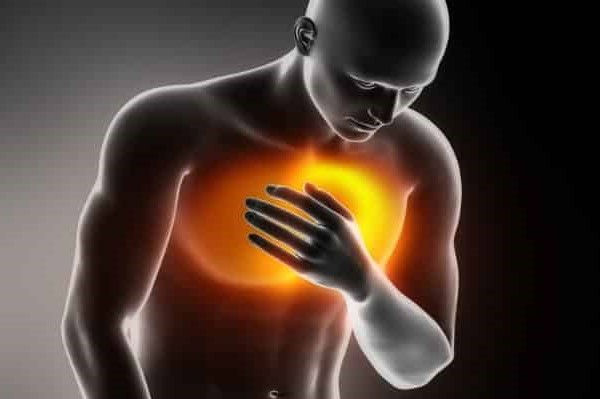
Fulminant and chronic pericarditis: ECG, treatment, contagion
Pericarditis is an inflammatory disease (acute or subacute) that affects the pericardium, accompanied by altered inflammatory indices (ESR, CRP), often gives intense pain, which increases in certain positions or by deep inhalations, sometimes radiating
A small amount of fluid between the two pericardial leaflets (between 25 and 50 ml of fluid) is physiological, but when there is inflammation, the fluid can increase to the point of being considered a ‘pericardial effusion’, which can vary greatly in magnitude but which most often resolves with medical treatment, although it should never be underestimated (an acute and severe pericardial effusion can be fatal in a fulminant manner).
Alterations in the electrocardiogram, sometimes even striking (such as ST-segment changes), are often present, although not always typical, and pericardial rubbing on auscultation.
Pericarditis should be distinguished from other pathological effusions which are:
- Hydropericardium: which occurs when the effusion is a transudate, when there is a persistent increase in venous pressure in the thoracic veins or when there is an imbalance between hydrostatic pressure and oncotic pressure (typical of heart failure or nephrotic syndrome)
- Haemopericardium: when the pericardial cavity is invaded by blood that may come from ruptured vessels running laterally.
Acute pericarditis manifests itself with:
- chest pain;
- fever;
- asthenia;
- general malaise;
- dyspnoea.
Chest pain is similar to that caused by myocardial infarction, as it is mediated by the same innervation, so it is referred to the precordial region, shoulder, left arm and left side of the neck.
Characteristically, the pain of pericarditis is aggravated by chest movements and coughing.
The patient tends to assume a genupectoral position to try to relieve symptoms.
Symptoms may be proportional to the extent of the effusion, but this is usually a complication.
Modest arrhythmias, generally of atrial origin, may sometimes occur.
If cardiac tamponade occurs, the symptoms are those of cardiogenic shock, with:
- tachycardia;
- low systolic blood pressure;
- low cardiac output;
- pulmonary congestion;
- paradoxical pulse;
- agitation and confusional state;
- dyspnoea;
- cold skin;
- pale.
Constrictive pericarditis generally causes no symptoms as long as systolic function is preserved.
ECG EQUIPMENT? VISIT THE ZOLL BOOTH AT EMERGENCY EXPO
In the case of a significant diastolic deficit, it manifests itself with:
- congestion of the neck veins in inspiration;
- peripheral oedemas;
- atrial fibrillation;
- hepatomegaly.
In the case of systolic impairment, the symptoms are:
- dyspnoea;
- asthenia,
- both also severe caused by pulmonary congestion.
Causes of pericarditis
Most of the time the cause remains unknown (idiopathic pericarditis), other times the cause is identified in diseases of infectious or autoimmune origin.
Idiopathic origin is a diagnosis of exclusion, after investigations of bacterial, viral infections and autoimmune diseases have proved negative.
Myocardial infarction or invasive cardiac procedures are rare but possible causes of pericarditis.
Pericarditis may also be a direct or indirect result of:
- disease of neighbouring organs or structures;
- tuberculosis;
- neoplasms;
- immunodeficiencies;
- renal insufficiency;
- leukaemias;
- chest trauma;
- radiotherapy.
Pericardial effusions are sometimes asymptomatic or not accompanied by inflammation: in these cases it is important to exclude tuberculosis, neoplasms and hypothyroidism.
If no cause is found, the effusion is monitored over time, when possible avoiding pericardiocentesis or invasive diagnostic manoeuvres.
Autoimmune diseases that can cause pericarditis are:
- systemic lupus erythematosus;
- rheumatoid arthritis;
- Sjögren’s syndrome;
- rheumatic fever.
Is pericarditis contagious?
One of the possible causes of pericarditis is an infectious disease caused by viruses or bacteria: in this case, as with other diseases caused by pathogenic micro-organisms, contagion is indeed possible and can occur by various routes, the most frequent being transmission by air, i.e. by the emission of droplets that typically occurs with breathing/coughing/sneezing, as can occur, for example, during flu epidemics.
Therapy of pericarditis
Treatment is based on the use of anti-inflammatory drugs (NSAIDs) and high-dose aspirin.
To prevent recurrences, many studies indicate the usefulness of colchicine, even at low doses (0.5-1 mg/g).
Cortisone treatment is the most common, but also an important cause of relapses.
Antibiotics are often administered if infection is suspected.
Progression of pericarditis
Once the acute phase has passed, both haematological (blood tests) and instrumental (echocardiography) controls must be repeated at regular intervals for a variable period.
The prognosis is good in most cases, even in the presence of recurrences.
Constrictive pericarditis, as well as cardiac tamponade, are rare events.
Read Also:
Emergency Live Even More…Live: Download The New Free App Of Your Newspaper For IOS And Android
Do You Have Episodes Of Sudden Tachycardia? You May Suffer From Wolff-Parkinson-White Syndrome (WPW)
Myocarditis: Causes, Symptoms, Diagnosis And Treatment
Cardiomyopathies: What They Are And What Are The Treatments
Knowing Thrombosis To Intervene On The Blood Clot
Inflammations Of The Heart: What Are The Causes Of Pericarditis?
Pericarditis: What Are The Causes Of Pericardial Inflammation?
Pericarditis In Children: Peculiarities And Differences From That Of Adults
Inflammations Of The Heart: What Are The Causes Of Pericarditis?
Do You Have Episodes Of Sudden Tachycardia? You May Suffer From Wolff-Parkinson-White Syndrome (WPW)
Knowing Thrombosis To Intervene On The Blood Clot
Patient Procedures: What Is External Electrical Cardioversion?
Increasing The Workforce Of EMS, Training Laypeople In Using AED
Difference Between Spontaneous, Electrical And Pharmacological Cardioversion
What Is Takotsubo Cardiomyopathy (Broken Heart Syndrome)?




